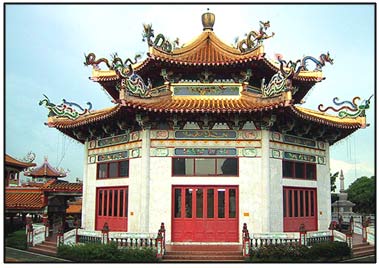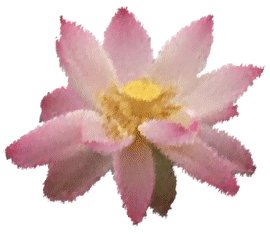
![]()
The Chinese Temple
Brief History
Buddhism spreads to China since the Han Dynasty. Historical records states that the Han Emperor in AD 67 some 500 years after the passing of Buddha, sent special envoys to India to invite Buddhist monks to come to China to teach Buddhism. It was the nature of the Chinese to put priority to education of 'filial piety' that this envoy was sent and at that period, it was regarded as an educational system and not religion.
The Chinese education at that period before Buddhism was based on 'filial piety' as was with Buddhism. When Buddhist monk from India and stated to discuss with the government officials it was immediately apparent to everyone that Buddhism share numerous similarities to the pillar of Chinese society 'filial piety' and it was easy to be accepted. The government consequently embraced them and requested the monks to teach permanently.
At that time, the Indian monks was carrying Sanskrit/Pali scriptures and translation to the Chinese characters was not easy. The monks adapted the characters and style used in Chinese and Taoist literatures for Buddhist Scriptures' better understanding for the locals. Hence, there might be some Taoism interpretation to Buddhism.
The first two monks who came to China was Chufarlan and Moton was received by the 'Hong-Lu-Si" which is equivalent to Foreign Ministry at that time. 'Si' was designated as a ministry of the government. However 'Hong-Lu-Si' could only receive guests temporarily.
In order for them to stay permanently, the Emperor establish another ministry called 'Bai-Ma-Si' to take charge of Buddhist education. The word 'Si' have nothing to do with temple but merely denoted a ministry of the court. Now it denote a temple in Chinese. So they were two ministry handling education with the other is 'Li-Bu' that is managed by the Prime Minister handling traditional Confucian system. This organization serves till the end of Chinese Imperialism.
With the support of the Enmperor, 'Bai-Ma-Si' system spreads rapidly throughout China and even surpassed 'Li-Bu' system at times. Consequently, there may not be a Confucian school in every village but there may be a 'Si' everywhere which is also used for sutra translation.
The scale of sutra translation is hard to imagine at that period for the karma has it that one who translate sutra will bear good karma. There was records that at 7th century, the famous monk, Xuan-Tsang has supervised 600 scholars alone in a 'Si' to translate sutra. Another monk named Kumaraja before that period supervises 400. Therefore, in the beginning, the 'Si' is in fact a large government ministry that focuses on education.
That is why, the Chinese Temple bears so much resemblance to other Chinese Imperial court that uses 'sze he yuan' in it's planning as well as it's Chinese styles in it's architecture. It was meant to be a ministry office. Unfortunately, some 2 centuries ago it was turned to a place for superstition and spirits.
When the immigrants from China came to South East Asia, they brought with them their understanding of their Chinese temple along. Hence, most of this temple are built according to the tradition and architecture of Chinese.

The Images of Buddha in the Temple
Buddhist does not practice idolatry worshiping. The principle to the images of Buddha is to be symbolical to serve as reminders of their respective qualities. A picture worth a thousand words. It was actually meant for education. When a Buddhist kneels down before the image of Buddha, he does not worship the holy image but brings to mind the great compassion of the Enlightened One who has taught the world the way to Deliverance.
The images used are therefore aids to generating faith and devotion in the minds of believers and are objects worthy of reverence. When one bow or kneel before the image of Buddha it is also an act of respect and veneration to the respective Buddhas.

Previous Next
![]() This
is a thesis website by ressox studio.
This
is a thesis website by ressox studio.

